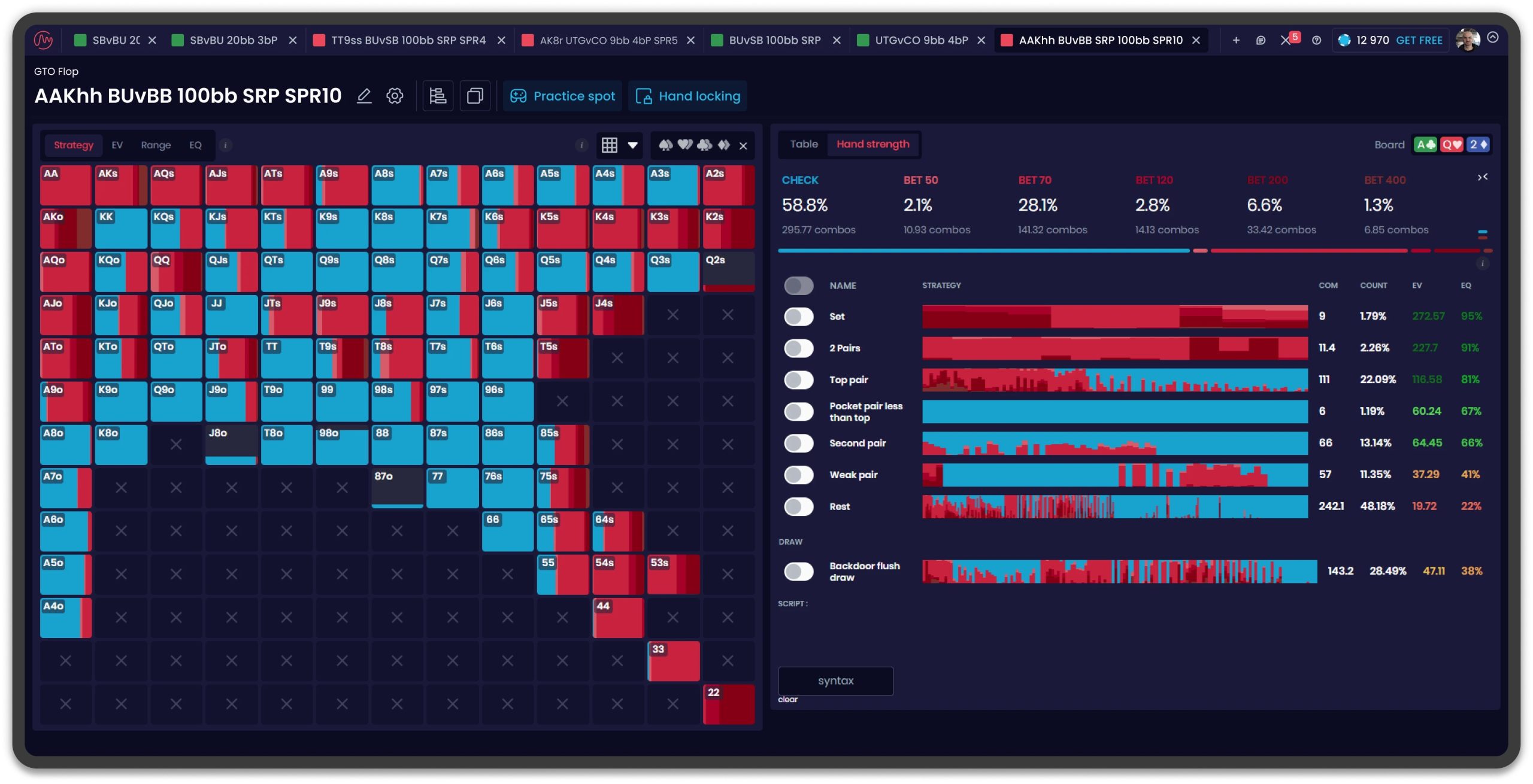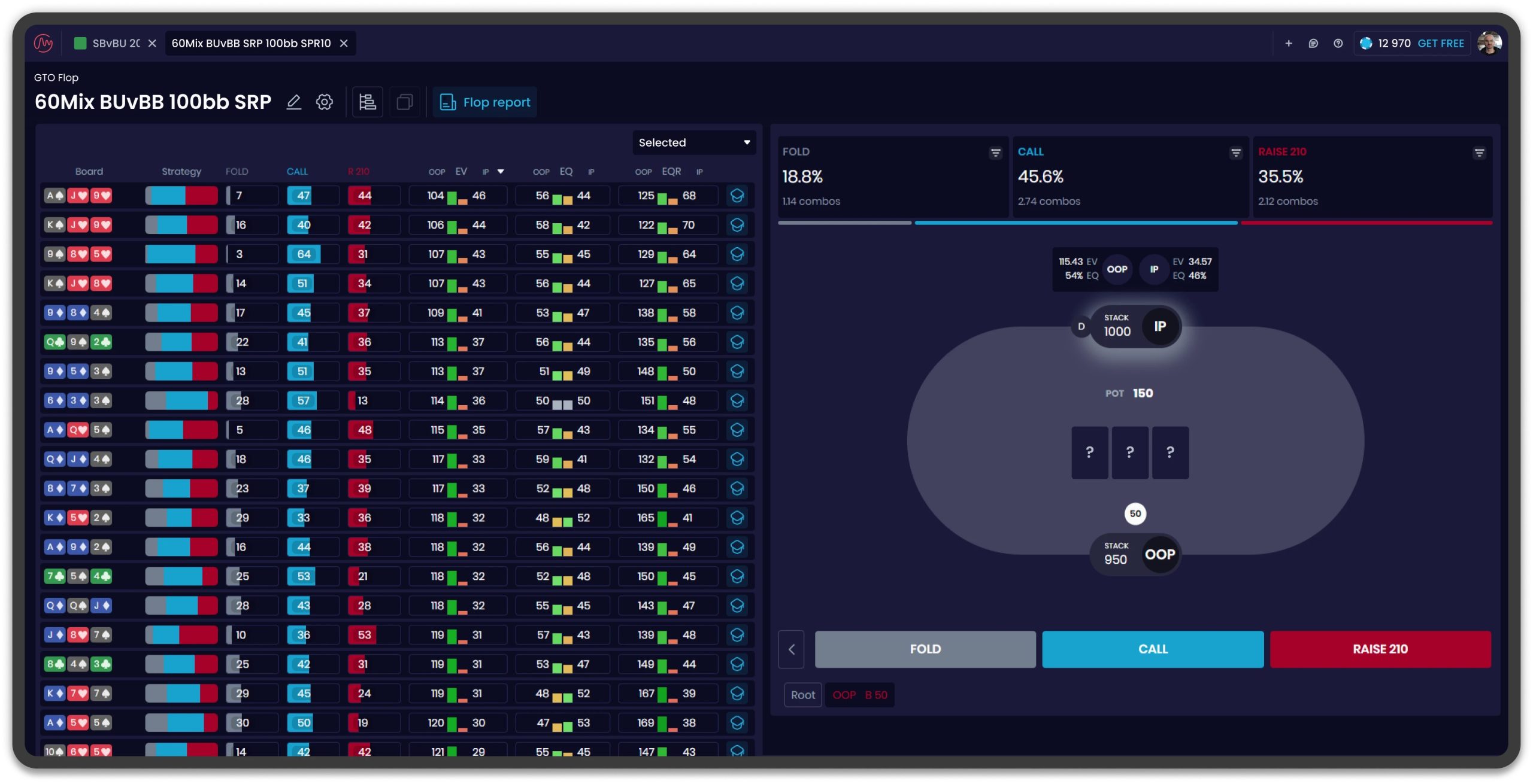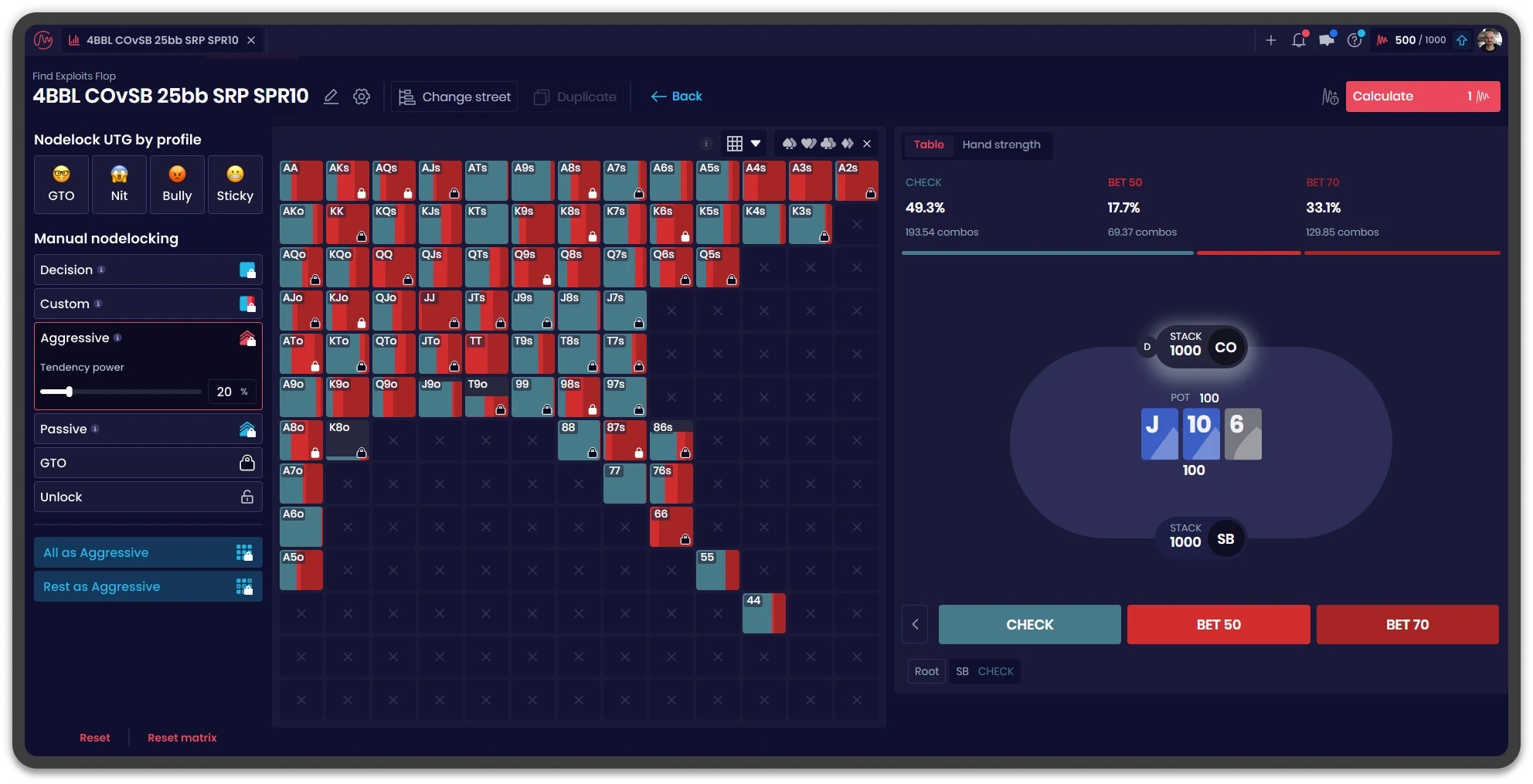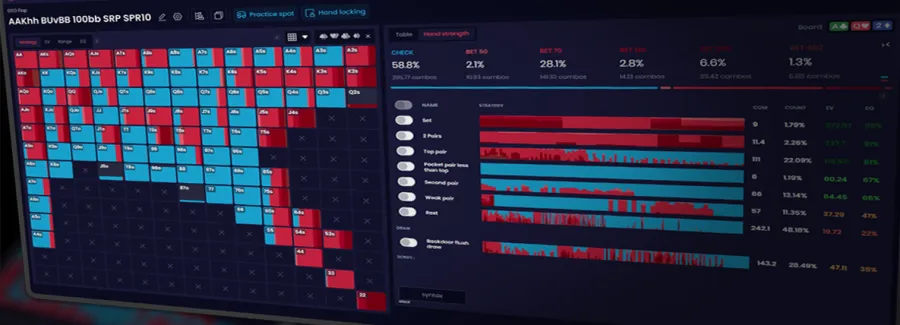If you’ve been around the poker community over the past few years, you’ll have noticed a substantive change in the way people talk about the game. It’s all “GTO” this and “solver-approved” that, but what exactly is a poker solver, and how can it help you become a better player? That’s exactly what we’ll be looking at in this article, so keep reading if you want to know everything there is to know about poker solvers.
Poker solvers are powerful tools that can help players improve their game by providing detailed analyses of specific hands and situations. A poker solver is a piece of software that uses advanced algorithms to analyse a given poker situation and determine the optimal strategy. The solver considers factors such as the player’s hole cards, the board cards, the opponent’s range, and the betting action to calculate the expected value (EV) of each possible action.
How do poker solvers work?
As we mentioned above, the solver uses an advanced algorithm to reach an “optimal” solution by considering various factors that impact the hand, such as each player’s range, the board, and the bet sizes. It does this by pitting each strategy against the other until neither side can gain more EV by altering their strategy. In essence, it works like this:
Player A has a strategy; Player B adjusts to that strategy to maximally exploit it; Player A then readjusts to maximally exploit Player B’s strategy; Player B then adjusts again to maximally exploit that strategy; and so on and so on until neither side can change their strategy to gain more EV.
The solver can be described as omniscient, as it knows exactly what hands are in each player’s range and what strategy each player will use. Doing so allows it to create an optimal strategy for both players.
However, the solver won’t work on its own; you need to provide the inputs for it to work. This means that you need to input your range, your opponent’s range, the bet sizings you’d like it to use, whether or not your opponent will lead on any street, the stack sizes, and the flop, turn, or river, depending on what street you’re trying to solve. If your inputs aren’t accurate for your situation, your outputs won’t be either, so make sure you accurately reflect the situation you’re trying to calculate.
 Check your hand strength using a poker solver like DeepSolver
Check your hand strength using a poker solver like DeepSolver
What can you study?
You can study almost every poker situation using a solver, whether it’s preflop, flop, turn, or river. You can work on the building blocks of poker by solving for optimal preflop ranges, even going so far as to adjust for different rake structures, work on your river play by analysing various hands on the most important street, and everything in between.
However, your access to these solutions will depend on the type of poker solver you have, as some solvers will restrict access to things like preflop solutions unless you buy the “Pro” or “Advanced” versions. However, some of these versions cost upwards of $1000, which is a bit beyond the bankroll of the average player.
This is why people are moving towards a cloud computing solver model, where you can access state-of-the-art cloud computing technology to run any simulation you can think of. Many popular poker solvers use this method, such as DeepSolver, giving players a wider range of options at a much more affordable rate.
How should you use them?
But how exactly should you use poker solvers? You may think from the description so far that you can input any poker scenario and press a button to give you the right answer, but it’s not quite as simple as that.
When you run a calculation through a solver, you aren’t given a “correct” answer for how to play a hand; you’re given a poker hand matrix with the optimal strategy in each section. This is because solvers don’t calculate for one hand versus your opponent’s range; they look at your whole range versus your opponent’s range.
While it’s tempting to create a simulation for the one hand that you had in a situation you found difficult in-game, it’s not the most efficient way to use a solver. Rather than using it to find the “solution” to one particular hand, you should look at how the solver plays the whole range and make inferences from there.
For example, suppose you simulate a situation from the flop. In that situation, you might think that you should be betting only a small percentage of the time with the strongest portion of your range, but the solver is actually betting with most of its range due to the EV differences between the two ranges. Insights like this are incredibly valuable for getting a deeper understanding of poker, as it allows you to view your hands on a more macro scale, which in turn makes you play better with a larger number of hands.
This kind of insight can be multiplied by taking advantage of the flop aggregator tool. This tool allows you to view how the solver plays your range across a multitude of different flop types, which you can then use whilst playing in-game. It’s a tool that’s not used as often as it should be, as it allows you to master the strategy for a number of different flop types in a very short space of time.
 DeepSolver’s Flop Report
DeepSolver’s Flop Report
You should also be using your solver as a way to understand the baseline level of “GTO,” which you can then use to compare against your opponents. By understanding how to play “properly,” you’re able to identify when your opponents are playing too loose or too tight. If you don’t have this understanding of GTO play, you’d only be guessing as to how your opponents are playing compared to the optimal strategy.
Once you know how your opponents are playing compared to what they should be playing, you can then adjust your strategy. For example, if your opponents are playing too loose and bluffing too often, you can counter that by calling more hands and being more aggressive against bets. Similarly, if your opponents are playing too tight, you can fold more hands versus their bets and play more aggressively when they check.
Common mistakes people make while using poker solvers
While solvers are an incredibly powerful piece of tech that can be used to make you a much better player, they’re only as good as the people using them. You can’t press a magic button and have it tell you how to be a better player; you need to understand how your inputs affect the outputs and know how the results apply to the games you play in regularly. Lots of people who use solvers use them incorrectly, and these are some of the most common mistakes they’ll make:
Running them on an old PC
Solvers take an extraordinary amount of processing power to calculate their results. They take into account so many different variables and permutations when calculating a hand, particularly if you are running preflop or flop calculations; it can take hours or even days to complete if you’re making those calculations on a substandard PC. However, rather than shelling out for top-of-the-line hardware, many people are moving to a subscription service, such as DeepSolver, which offers cloud-based solver calculations. Rather than having to run it from your out-of-date machine, you can use the latest in cloud computing technology to get the answer to your most burning poker questions.
Inputting Incorrect Ranges
One of the most important things to do when using a poker solver is to be mindful of the preflop ranges you input at the start of the hand. The solver will use both your and your opponent’s ranges to calculate the EV of each strategy for each hand, so if any of those ranges are inaccurate, you’ll get inaccurate results. Remember to tailor your ranges based on the type of player you’re playing against. Create ranges that are looser than the optimal opening range for loose players, and create ranges that are tighter than the optimal opening range for tight players.
Taking The Solver’s Word As Gospel
Arguably the biggest mistake a player can make is to take the solver’s output as the only correct way, and rigidly apply their solver’s solutions to every situation. Remember, the solver will give you outputs based on your inputs, and while those outputs are going to be optimal for that exact situation, it’s unlikely that this situation will always apply in real life. People don’t often play optimal ranges, so the highest EV strategy may differ against players who are playing sub-optimally. The key to using a poker solver efficiently at the lower stakes level is to use it to get a baseline understanding of what you should play and then compare that to how your opponents are playing. Are they playing tighter or looser than they should, and what should you do to counter it?

What are the pros and cons of poker solvers?
There’s no doubt that poker solvers are a net positive in the world of poker learning. Our understanding of the game has been greatly increased because of their presence, but as with everything in life, nothing is perfect. There are some downsides to using a poker solver, so let’s look at the pros and cons of using one.
Pros
- Get Optimal Postflop Solutions – This is the biggest advantage of using a poker solver; as long as you’ve entered the correct inputs, you can discover the optimal way to play your hand. Not only is this great for understanding how to play a particular hand, but you can extrapolate the information to understand how to play your whole range in common poker scenarios, making you much tougher to play against.
- Calculate Optimal Preflop Ranges – Another major advantage of using a poker solver is that you can calculate optimal preflop ranges for the games you play. You can input the stakes, your stack size, and the rake structure and get optimal preflop ranges based on that information. You’ll never have to worry if you’re playing too tight or too loose ever again!
- Understand How To Exploit Your Opponents – By using a poker solver, you get to learn what it means to play Game Theory Optimal poker. Once you have a solid understanding of this type of poker, you can use it to identify when your opponents are deviating from it. For example, suppose you see your opponents bluffing with a hand that should never be bluffed. In that case, you can extrapolate that information and assume that your opponent is often overbluffing, so you can call them down wider and expect to win more often.
Cons
- It’s Only As Good As Its Inputs – A poker solver is not a magical “solve poker” button; it requires a great deal of input from the user before it’s able to calculate and display accurate information. If your inputs are incorrect for the situation you want to analyse, your results will be faulty, and the information and insights you may glean from the outputs may not be accurate.
- One Calculation At A Time – Another downside is that you can only run one calculation at a time. This means that if you want to calculate a variety of different spots, it will take a lot of time for the solver to run and to fully analyse the position for each one. While cloud computing solves this problem to an extent, it still doesn’t solve the issue that you can only study one scenario at a time.
- Results Aren’t Always Applicable – One of the biggest misnomers about poker solvers is that they’re the gospel truth of how to play a poker hand. However, the solutions you see are based on two players playing optimally against one another. Fortunately for us, every player we play against will be making some kind of mistake, with many players at the lower stakes making dozens of mistakes an hour. This means that the solver outputs won’t show the most optimal way to play, as if your opponent is making a mistake, you can adjust your strategy to exploit that. This is why it’s important to use poker solvers as a way of understanding what GTO play is, which you can then use to exploit your opponents.
 Discover how to exploit your opponents by using a poker solver. This is the ‘Find Exploits’ report from DeepSolver
Discover how to exploit your opponents by using a poker solver. This is the ‘Find Exploits’ report from DeepSolver
Summary
It’s true that poker solvers have taken studying the game of poker to a new level, but only for those who truly understand how to use them. They take a lot of understanding to use correctly, and players must temper their expectations for what they can expect, as understanding solver outputs and what they mean will take a lot of patience and time. However, by learning how to interpret solver inputs and understanding GTO play to the point where you can identify errors in your opponents, you can further yourself as a poker player and increase your edge in the games you play.





















